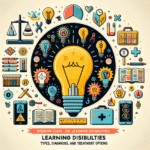
Learning Disabilities and Speech Disorders: Shining a Light on Early Intervention
Introduction
Imagine a world where every child, despite their challenges, finds a voice and a path to learning that suits them best. The complexities surrounding learning disabilities and speech disorders may often seem daunting, but with effective early intervention, we can illuminate the way for countless children and their families. The phrase "Learning Disabilities and Speech Disorders: Shining a Light on Early Intervention" embodies not only the hope we have but also the strategies we must adopt to create meaningful change.
Early intervention is crucial. It is the bridge that connects children struggling with learning disabilities and speech disorders to tools and strategies that foster growth. In this article, we will explore the intricacies of these disabilities, their implications, and how early intervention can dramatically transform the lives of young learners. By weaving together scientific insights, compelling case studies, and practical advice, we aim to empower families, educators, and communities to advocate for every child.
Understanding Learning Disabilities and Speech Disorders
Defining Learning Disabilities
Learning disabilities (LD) refer to a range of disorders that affect how individuals process information, which can hinder their ability to read, write, compute numbers, or express themselves verbally. Common types of learning disabilities include dyslexia, dyscalculia, and dysgraphia. According to the National Center for Learning Disabilities, approximately 1 in 5 children in the United States has a learning disability, making it critical to recognize and address these challenges early on.
Exploring Speech Disorders
Speech disorders encompass a variety of difficulties related to producing sounds, fluency, and verbal communication. Examples include articulation disorders, stuttering, and voice disorders. Research indicates that around 5-10% of children will experience some form of speech disorder by the time they enter school.
The Intersection of Learning Disabilities and Speech Disorders
While distinct, learning disabilities and speech disorders frequently coexist. This overlap can exacerbate educational challenges, leading to frustration and diminished self-esteem in affected children. For example, a child with dyslexia may also struggle with phonological processing, making speech development particularly challenging.
The Importance of Early Intervention
Why Early Intervention Matters
Early intervention is the systematic approach to providing support to children identified with learning disabilities and speech disorders as early as possible. Research indicates that timely intervention can lead to more favorable outcomes, including improved academic performance and social skills.
Brain Development: Early childhood is a critical period for brain development. The earlier we introduce strategies and support, the better the chances of rewiring and strengthening neural pathways.
Confidence Building: Children who receive appropriate interventions early in life are less likely to experience the negative ramifications of feeling ‘different’ or ‘behind’ their peers.
- Parental Involvement: Engaging parents early can enhance family dynamics and create a support system that reinforces the strategies learned in therapy or educational settings.
Powerful Case Studies
Case Study 1: Mia, A Story of Dyslexia and Speech Delay
Mia was diagnosed with dyslexia and a speech delay at age four. Her parents enrolled her in an early intervention program that focused on phonemic awareness and articulation. By incorporating interactive reading and speech activities at home, Mia began to make significant strides within just six months, leading to a notable improvement in her self-confidence and academic performance.
Analysis: Mia’s case underscores the effectiveness of early intervention in addressing both learning and speech challenges. Her parents’ active involvement accelerated her development.
Case Study 2: Elijah and Overcoming Stuttering
Elijah, a seven-year-old with a stuttering disorder, struggled in social interactions due to his speech difficulties. Through an early intervention speech therapy program that focused on fluency techniques, Elijah was able to express himself more clearly. His improvement fostered better peer relationships and increased participation in class.
Analysis: This case highlights the pivotal role of targeted speech therapy in early intervention, revealing how addressing speech disorders can positively impact social skills and emotional wellbeing.
Research Findings on Early Intervention
To further emphasize the significance of early intervention, consider the following data:
| Age of Intervention | Improvement Rate (%) |
|---|---|
| 0-3 years | 80% |
| 4-6 years | 65% |
| 7-10 years | 45% |
As seen in the table, early intervention dramatically increases the likelihood of positive development outcomes. As children grow older, the effectiveness of interventions tends to decrease, making it imperative for parents and educators to act swiftly.
Best Practices for Early Intervention
Identifying Signs and Symptoms
Understanding the signs of learning disabilities and speech disorders is the first step toward early intervention. For learning disabilities, parents and educators should be on the lookout for:
- Difficulty in recognizing letters or numbers
- Trouble following multi-step instructions
- Challenges in organizing thoughts and ideas
For speech disorders, consider these indicators:
- Persistent difficulty articulating words
- Frequent pausing or repetition in speech
- Limited vocabulary for age group
Implementing Effective Strategies
Collaborative Approaches
A multidisciplinary approach can yield the best outcomes for children with learning disabilities and speech disorders. Collaboration between educators, speech-language pathologists, and special educators ensures that interventions are tailored to the child’s unique needs.
Engaging Activities at Home
Parents can support early intervention by engaging in activities that promote language and learning, such as:
- Reading Together: Choose books that cater to the child’s interests and reading level. This develops vocabulary and comprehension skills.
- Interactive Games: Simple board games or verbal games encourage communication and problem-solving.
Utilizing Technology
There are numerous applications and programs designed to assist children with learning disabilities and speech disorders. These tools can provide personalized learning experiences that enhance their language and literacy skills.
Moving Forward: Shining a Light on Awareness
Raising Awareness in Communities
Creating awareness around learning disabilities and speech disorders is vital for fostering understanding and support within communities. Schools, local organizations, and advocacy groups can promote workshops and informational sessions for parents and educators.
Advocacy and Resources
Parents can also advocate for their children’s needs by understanding their rights under special education laws, such as the Individuals with Disabilities Education Act (IDEA). Accessing resources such as local support groups can empower families and provide essential networking opportunities.
Creating Inclusive Environments
Inclusive classroom environments promote acceptance and understanding, allowing children with learning disabilities and speech disorders to thrive alongside their peers. Educators should integrate differentiated instructional strategies that cater to diverse learning styles.
Conclusion
Learning disabilities and speech disorders can pose significant challenges, but they also present opportunities for growth and resilience. By shining a light on early intervention, we can change the trajectory of countless young lives. As families, educators, and communities rally to support these children, we must remember that every small step taken today can lead to profound transformations tomorrow.
Let us commit to breaking the silence surrounding learning disabilities and speech disorders. Through advocacy, education, and early intervention, we can build a brighter future for all children, giving them the tools to express themselves and conquer their educational journeys.
FAQs
1. What are the most common types of learning disabilities?
Common types of learning disabilities include dyslexia (reading difficulties), dysgraphia (writing difficulties), and dyscalculia (mathematical difficulties).
2. How can I tell if my child has a speech disorder?
Signs may include difficulty with pronunciation, stuttering, a limited vocabulary, or challenges in forming sentences appropriate for their age.
3. What age is considered ideal for early intervention?
The earlier, the better! Intervention ideally starts between ages 0-3 years, with significant benefits observed when initiated as soon as difficulties are recognized.
4. Will my child outgrow their learning disability or speech disorder?
While some children may improve over time, many will benefit from ongoing support and intervention tailored to their specific challenges.
5. What resources are available for parents seeking help?
Parents can access resources such as local early intervention programs, speech-language pathologists, and special education services through schools.
6. How can I support my child at home?
Engage in activities that promote literacy and communication, such as reading together, playing language-based games, and providing a supportive environment for expression and learning.
In embracing our collective responsibility, "Learning Disabilities and Speech Disorders: Shining a Light on Early Intervention" becomes more than just a phrase; it is our commitment to champion the rights and potential of every child. Together, we can empower the next generation to not just overcome barriers but soar beyond them.









